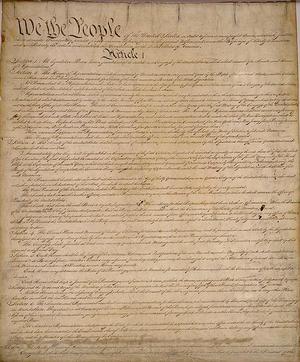Many of us are familiar with most of the 10 Amendments that make up the Bill of Rights section of the U.S. Constitution. However, other parts of this very important document often go unnoticed. One of those parts is Article 5 of the Constitution. Its purpose is to outline how the U.S. Constitution can be amended. We know the Constitution has been amended, (27 times, in fact) but do we really understand the process? First, let’s look at the actual text of Article 5 of the U.S. Constitution:
Article 5 of the U.S. Constitution:
The Congress, whenever two thirds of both Houses shall deem it necessary, shall propose Amendments to this Constitution, or, on the Application of the Legislatures of two thirds of the several States, shall call a Convention for proposing Amendments, which, in either Case, shall be valid to all Intents and Purposes, as part of this Constitution, when ratified by the Legislatures of three fourths of the several States, or by Conventions in three fourths thereof, as the one or the other Mode of Ratification may be proposed by the Congress; Provided that no Amendment which may be made prior to the Year One thousand eight hundred and eight shall in any Manner affect the first and fourth Clauses in the Ninth Section of the first Article; and that no State, without its Consent, shall be deprived of its equal Suffrage in the Senate.
That’s a lot to digest. So let’s take our time with this analysis.
Formal Changes
To start, Article 5 outlines only 2 methods by which the Constitution may be amended.
Method #1:
After a proposition put forth by 2/3 of both the House of Representatives and the Senate, a Convention is called to vote on the proposed amendment. Then, in order to become an amendment, 3/4 of the states’ legislatures have voted in favor of the amendment.
Method #2:
After a proposition put forth by 2/3 of the states’ legislatures, a Convention is called to vote on the proposed amendment. In order to become an amendment, 3/4 of the states’ legislatures have voted in favor of the amendment.
There is an exception to what amendments can be proposed. An amendment cannot be proposed that deprives a state of its equal representation in the Senate except by the state’s own consent.
To date, the only method that has been used to propose and amend the Constitution is by a 2/3 vote of each house of Congress. The other method is seldom used because many people believe that this method cannot be as easily controlled as with a Congressional vote.
When a proposed amendment gets to the ratification stage, Congress may put a time limit on how long states have to vote on the pending amendment. This time limit is usually 7 years.
Informal Changes
One of the reasons the U.S. Constitution has been able to keep pace with the changing times is because of informal change. These changes occur as government leaders and citizens fill in the details of government on a daily basis to suit the needs of the times.
Congress has passed laws that have enlarged or clarified many of the Constitution’s provisions. Examples of this include: tax laws; creating cabinet departments; passing the Judiciary Act of 1789; creation of additional federal courts, new rules of federal court procedure, and provided for court workers such as baliffs and clerks.
Changes Through Congressional Practices
The House may impeach federal officials including the President and the Senate determines guilt or innocence.
Informal Presidential Changes
Presidential Succession
In 1967 the 25th Amendment clarified presidential succession after a controversy was caused when William Henry Harrison died in office in 1841 and Vice President John Tyler took the Presidential Oath of Office.
Foreign Affairs
Modern presidents usually conduct foreign affairs by executive agreement instead of the treaty process specified in the Constitution. An executive agreement is made directly between the president and the head of another state. It does not require Senate approval.
Domestic Affairs
In the past couple of centuries, presidents have been more aggressive in requesting legislation from Congress (i.e. President Obama’s call for Healthcare Reform).
Court Decisions
Judicial Review
Judicial review is probably the most important device the Supreme Court uses to interpret the Constitution. People continue to disagree over how the Court should use this power. Some people advocate judicial restraint while others want judicial activism. Judicial restraint is when the Court avoids taking the initiative on social and political questions. Judicial activists believe the Court should play a role in answering these questions.
Chief Justice Earl Warren (1953-1969) accepted cases on many controversial issues, particularly Civil Rights and the rights of the accused. As a result, the Warren court was considered an activist court.
Since the 1940s, most activist policies have been in support of civil liberties. Political liberals have tended to support activism, while conservatives have tended to support judicial restraint.
Changing Court Rulings
Social and political conditions of the times often affect Court interpretations of the Constitution. For example, an 1896 (Plessy v. Ferguson) ruling on separate but equal facilities was later reversed in 1954 when the Court outlawed racial segregation in public schools (Brown v. Topeka Board of Education).
Sometimes changes occur through custom and usage. The Constitution has been enlarged informally through customs that have developed over time. An example of this is the development of political parties.
Key Terms
Ratify – to approve an amendment
Petition – an appeal
Balanced budget – when the federal government’s spending does not exceed its income
Impeach – accuse (a federal official to include the President)
Treaty – an agreement between nations; requires Senate approval
Executive agreement – made directly between the president and the head of another state or country; does not require Senate approval
Judicial restraint – the Court should avoid taking the initiative on social and political questions
Judicial activism – the Court should play a role in answering social and political questions
Sources:
U.S. Constitution.net
http://www.usconstitution.net/const.html#Article5




